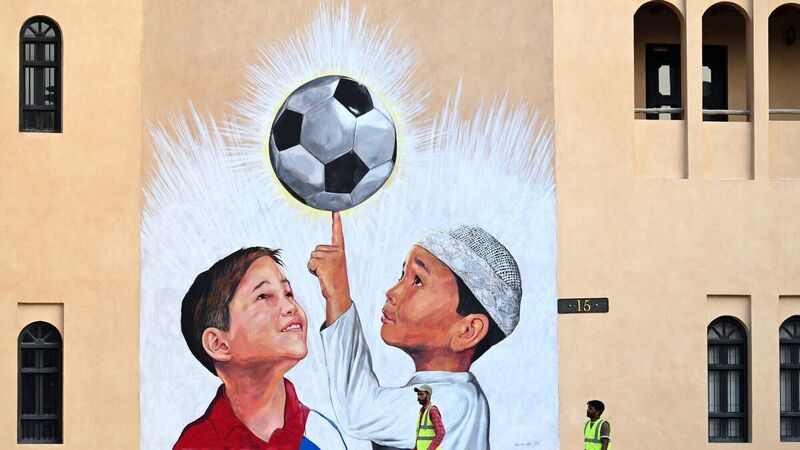Paul Rouse: The wonder, the obsession, the hope of a World Cup

DREAM FACTORY: A worker pushes a wheelbarrow past a mural in Doha
The first World Cup Final was played on Wednesday, July 30, 1930 in the Estadio Centenario in Montevideo, Uruguay. In the hours before the final, Buenos Aires port was emptied of boats. The rich sailed their yachts, while liners and steamers and tugboats crossed the Rio de la Plata bringing more than 10,000 Argentinians to a stadium that was filled to the point where tens of thousands of Uruguayans were locked outside.
All normal life in both countries was suspended as the match progressed. Argentina led at half-time by 2-1 and seemed set fair to go on and win. They collapsed in the second half, however, and were dominated by Uruguay who scored three goals to win by 4-2.
The scenes in Montevideo were as wild as your imagination can allow.
In Argentina, by contrast, there was a savage recrimination; some commentators decried the team for their perceived lack of courage. It was to take more than a half-century before the disappointment of that day was eased by Diego Maradona and his particular brand of magic in 1986.
But the journey was at least now underway.
Traditions of winning World Cups are built on the most fragile of moments; indeed, there is nothing inevitable about the success of any country.
Germany have won the World Cup four times (1954, 1974, 1990 and 2014). They have finished as runners-up on four other occasions (1966, 1982, 1986 and 2002). Bit is a record that places them only behind Brazil in the Roll of Honour.
And yet the first German success in 1954 was entirely unpredicted. The country had been slow to adopt the game; there was suspicion of soccer as an 'English' game and it was initially restricted to enthusiasts of das runde Leder (the 'round leather'). Soccer evolved into a significant spectator sport only in the 1920s.
As Wolfram Pyta has written, until 1963 German soccer had no national league. Instead, there were seven regional associations who had their own individual leagues. Ultimately, the best teams in each region played off a knockout competition, ending in a final, to find a national champion.
What drove progress before then was the emergence of soccer in Germany in the 1950s as a mass-media phenomenon through the national team.
This was something made possible by success in the 1954 World Cup when they defeated a brilliant Hungarian team in the final.
Indeed, what is striking is that ‘Frankfurter Allgemeine Zeitung’ (FAZ), the journal of the liberal middle classes, put a sailing regatta in Kiel on its front page rather than soccer when Germany played its first match in the 1954 World Cup Finals.
All of this changed by the end of the tournament, notably in the outpouring of emotion after Germany won the semi-final against Austria. Germany was also 2-0 down after 9 minutes in the final against Hungary, so there was enormous drama when they equalized quickly, withstood a barrage in the second half and then scored a winner 6 minutes from the end.
Live radio from Berne meant that as well as 20,000 Germans at the match, the whole country was also able to bear witness: “The World Cup final of 1954 was the first sports event in Germany to become a gigantic media event. This is why they could captivate millions of Germans who until then had viewed football with scepticism but were infected with the football virus due to the World Cup final and its presence in the media. Crucially, the game was reported not for a specialist audience but in a language by a commentator (Herbert Zimmerman) that was intelligible to the 50% of the population who were listening.”
The “Miracle of Berne” gave Germans the opportunity to rediscover a sense of nationalism in the aftermath of World War II. And in time, as Wolfram Pyta said, this miracle emerged as a sort of “cultural founding myth” for modern Germany which emphasized Germany’s rebirth through the triumph of the “traditional ‘German virtues’” of “discipline, competitive strength and a never-slackening will.”
Not playing in a World Cup leaves a mark on even the greatest players that a country produces. After Northern Ireland qualified for the 1982 World Cup, there was public pressure on the manager Billy Bingham to select George Best in his squad. Best had not played for Northern Ireland since the 1976–7 season.
By 1982 he was 35 years of age and still playing in America, having played for teams in the USA, South Africa, Ireland, Scotland, Hong Kong and Australia.
Bingham did not pick him and Best later reminisced: “I wouldn’t have expected to play every game, but I wished he had just taken me as a member of the squad and thrown me on for 15 minutes, only so I could have played in the World Cup.”
Liam Brady also missed out, when the Republic of Ireland qualified for the 1990 World Cup; indeed, his last game was a testimonial in his honour against Finland, the last home game before Italia ’90. But the manager Jack Charlton chose not to select him.
He later said: “I was surplus to requirements, Jack had lads in midfield who could get up and down the pitch, like Andy Townsend and Ronnie Whelan and maybe my style had had its time. Me and Jack got on, we always had a laugh together, I have no animosity towards him at all, my time had gone and moved on, that's what happens in football. If I had a different type of manager who believed in another type of football I could have been in that 1990 World Cup squad, but he wasn't that way inclined. So that's why I didn't go. It's a pity really as I had waited so long, I started in 1974, and this was 1990, so I had the best part of 16 years with the Irish team and to just miss out was a shame.”
There is also abject pain. World Cups have winners and losers, heroes and villains. The tournament thrives on the raw passions of all involved. The joy or the anguish is rarely contaminated by ambiguity; there is little room for emotional subtlety.
The brutality of some failures are never to be shaken. Take, for example, when Germany beat Brazil in the 2014 World Cup by 7-1. The reaction of the Brazilian public and of the press was vicious. The words that filled the front-page headlines were ‘disgrace’, ‘outrage’, ‘humiliation’.
Nobody who read them could have been left in any doubt just how match this match meant to the Brazilian people, who were expecting to win a home World Cup.
The Brazilian sporting daily newspaper, ‘Lance’, gave the Brazilian players an average score of 1.8 out of 10 for their performances in the match. To put this in context, it is only very rarely that any player will get a score even as low as 3 out of 10.
The agony of the Brazilian players as they played out those final minutes was not easy to watch – it is a cruel thing to watch people being shamed in public in so comprehensive a manner. Cruel, but compelling at the same time. And the fact that all of the players were millionaires could not insulate them from what they were feeling. No matter what else happens in their lives, they will always be remembered for that day – and they knew it.
On Sunday, Qatar play Ecuador in the opening match of the World Cup. The nature of Qatari society, its treatment of migrants and minorities, is well-established. But Ecuador, too, has a history whose legacy is apparent in the composition of its team.
Afro-Ecuadorians are central to the rise of the success of the Ecuador national team which qualified for World Cups in 2002, 2006, and 2014. The Afro-Ecuadorians players are descendants of slaves imported by the Jesuits in the sixteenth century. Although – as David Goldblatt has written – they constitute seven per cent of the population (with many living in poverty), they were essentially written out of the country’s soccer history and its wider national identity. They were also subjected to decades of racist chanting in stadiums.
The abuse endured has crossed national boundaries. The Peruvian sports commentator Phillip Butters said that of Afro-Ecuadorians, “if the players bite you, you’d get Ebola.” There has been progress but the racism against such players endures. Nonetheless, when they play, Ecuador’s fans chant in support of their team which is almost always an underdog: “Si se suede” – Yes, you can.














